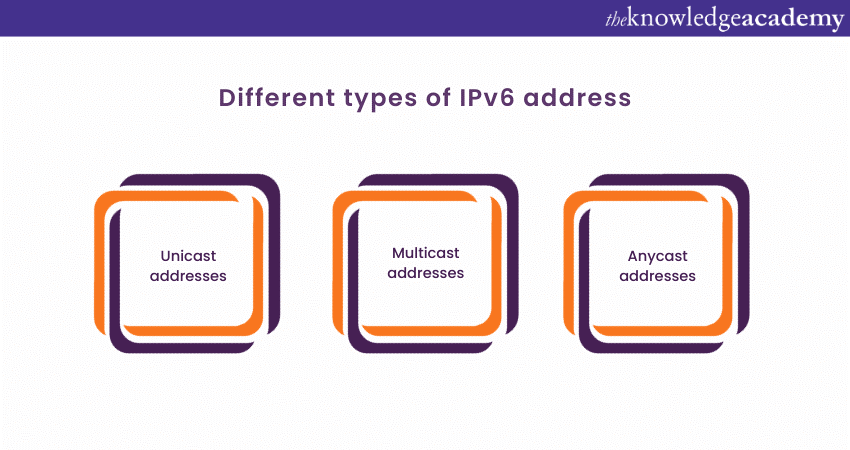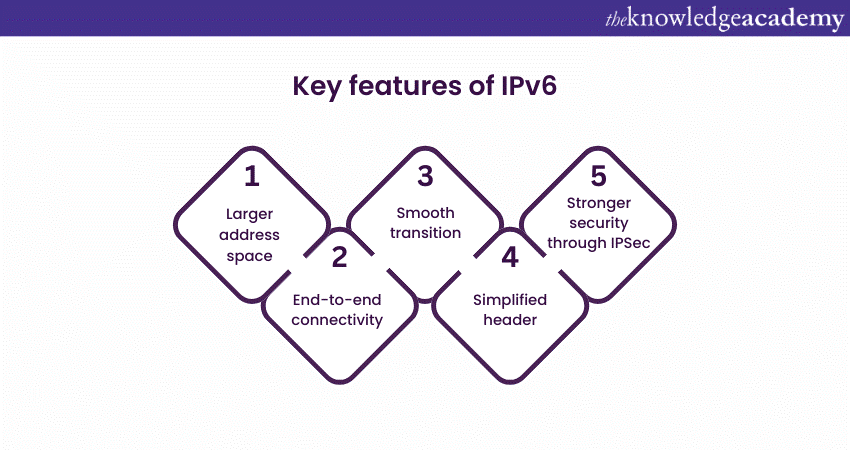We may not have the course you’re looking for. If you enquire or give us a call on 01344203999 and speak to our training experts, we may still be able to help with your training requirements.
Training Outcomes Within Your Budget!
We ensure quality, budget-alignment, and timely delivery by our expert instructors.

IPv6 stands as the latest iteration of the Internet Protocol developed by the IETF. It serves the purpose of identifying and locating endpoint systems within a computer network, efficiently directing online traffic. This protocol addresses the challenge of IPv4 address exhaustion caused by the prolonged use of the internet worldwide.
IPv6 (Internet Protocol Version 6) is the latest version of IP and a collection of guidelines that control data transmission & reception over the network. Read more to know more about What is IPv6, its key features and benefits!
Table of Contents
1) What Is IPv6 (Internet Protocol Version 6)?
2) Different types of IPv6 address
3) How does IPv6 work?
4) Key features of IPv6
5) Benefits of IPv6
6) Drawbacks of IPv6
7) Conclusion
What Is IPv6 (Internet Protocol Version 6)?
IPv6 is the latest iteration of the Internet Protocol devised by the Internet Engineering Task Force (IETF). It identifies and localises endpoint systems within a computer network, directing online traffic. This is aimed at mitigating the issue of IPv4 address exhaustion resulting from prolonged global internet usage.
Internet Protocol version 6 (IPv6) operates as a network layer protocol facilitating communication across the network. Each internet-connected device possesses a unique IP address, enabling its identification and location. In the 1990s digital revolution, it became evident that the IP addresses employed by Internet Protocol version 4 (IPv4) to link devices would fall short of meeting escalating demand.
Consequently, the IETF embarked on developing the next generation of Internet Protocols. IPv6 achieved draft standard status for the IETF in December 1998, and on July 14, 2017, it gained approval as an internet standard for global implementation.
Different types of IPv6 address
The following are the different types of IPv6 addresses:

1) Unicast addresses: It denotes a singular node within a network, typically signifying either a lone sender or receiver.
2) Multicast addresses: It signifies a collective of IP devices and can solely serve as the designated destination for a datagram.
3) Anycast addresses: It is allocated to a group of interfaces, typically associated with distinct nodes.
How does IPv6 work?
The working of IPv6 relies on the following key concepts:
1) Decoding IPv6 addresses
An IPv6 address comprises 128 bits, four times more than its IPv4 counterpart, which utilises only 32 bits. Unlike IPv4, IPv6 addresses are expressed in hexadecimal rather than dotted decimal format. A complete IPv6 address comprises 32 hexadecimal digits, given that each hexadecimal digit represents 4 bits. These digits are arranged into eight groups of four and separated by colons (:)—for example, group6: group7: group8: and so forth.
Due to its extended length, an IPv6 address may undergo abbreviation using various techniques. For instance, the address 2001:0db8:0000:0000:0000:7a6e:0680:9668 can be abbreviated to 2001:db8::7a6e:680:9668. The primary method involves eliminating leading zeros. Furthermore, consecutive segments of zeros can be substituted with two colons (::). However, it is advisable to apply this method sparingly in a given address to prevent ambiguity or indeterminacy.
Improve your networking skills with our Troubleshooting and Maintaining Cisco IP Networks Course - visit the link to join!
2) Network and node addresses in the IPv6 landscape
In IPv4, address classes were employed to divide an address into two parts: a network section and a node section. Subsequently, this method was supplanted by subnet masking. Likewise, in IPv6, an address is partitioned into two segments. The address is segregated into two 64-bit portions. The upper 64-bit portion constitutes the network section, while the lower 64-bit segment is the node section.
The upper 64-bit segment (network component) is utilised for routing. The lower 64-bit element (node component) specifies the address of the interface or node. The node component is generated from the actual physical or MAC address using the IEEE’s extended unique identifier (EUI-64) format.
The computer network component is divided into two blocks of 48 and 16 bits, respectively. The lower 16 bits are managed by a network administrator and are designated for subnets on an internal network. The upper 48 bits are allocated for internet routing and are employed for global network addresses.
3) Navigating IPv6 address types and their scope
There are three categories of IPv6 addresses:
1) Global unicast addresses: These can be routed on the internet and commence with 2001:. The information conveyed in network announcements by routers determines the prefix for international unicast addresses. They are equivalent to IPv4 public addresses. For "stateless address autoconfiguration" (SLAAC), which requires a block of 64 addresses, Internet authorities allocate address blocks to Internet service providers (ISPs) for distribution to their customers. The recommendation is to give more than one 64 to home sites.
2) Unique local addresses: Intended for usage within an internal network, such as a local area network, these addresses are routable within the internal network but not on the internet. The address allocation space is divided into two /8 spaces – fd00::/8 for globally assigned addresses and fc00::/8 for locally assigned addresses. Organisations have the option to configure addresses manually using the fd00 prefix.
3) Link-local addresses: Reserved for use within an internal network, these addresses are routable within the internal network but not on the internet. Additionally, they are analogous to the IPv4 address range 169.254.0.0/16, assigned on the IPv4 network without a DHCP server. Link-local addresses commence with the prefix fe80. Even without routing, each IPv6 interface must be configured with a link-local address.
Master the basics of networking concepts by signing up for our Cisco Certified Network Professional Boot Camp Week 1 Course now!
4) Integrating IPv6 addresses into uniform resource locators
When utilising an IPv4 network, users can connect to a network resource like a webpage through HTTP://192.168.121/webpage. Webpages can also be reached via IPv6, albeit with a modification in the format. IPv6 addresses employ a colon as a separator and must be enclosed in square brackets.
5) Unveiling the functionality of IPv6 loopback
The loopback address corresponds to the same interface as a computer. The TCP/IP protocol stack redirects packets back to the same interface in IPv4 and IPv6. In IPv4, the 127.0.0.0/8 network is designated for loopback addresses. In IPv6, the loopback address is 0000:0000:0000:0000:0000:0000:0000:0001/128, which can be simplified to ::1/128. Routers in both IPv4 and IPv6 will not forward packets with an undefined address. The unspecified address in IPv6 is ::/0.
Key features of IPv6
Let's delve into the key features that make IPv6 a game-changer in internet communication.

1) Larger address space
One of the most conspicuous advantages of IPv6 is its substantially larger address space. In the realm of IPv4, the 32-bit address format limited the number of unique addresses available. IPv6, however, adopts a 128-bit address format, unlocking an astronomically larger pool of unique addresses. This expansion responds to the escalating demand for IP addresses in our ever-expanding digital ecosystem.
2) End-to-end connectivity
IPv6 champions end-to-end connectivity, fostering direct communication between devices across the internet. Unlike IPv4, where Network Address Translation (NAT) was often employed to manage address scarcity, IPv6 eliminates the need for such workarounds. This direct communication approach facilitates more efficient data transfer and reduces the complexity introduced by NAT.
3) Smooth transition
The transition from IPv4 to IPv6 is a critical step to ensure the sustained growth of the internet. IPv6 is designed to focus on seamless coexistence with IPv4 during this transition phase. This interoperability allows networks and devices to gradually migrate to IPv6 without disrupting existing IPv4 systems. This foresight ensures a smoother and less disruptive evolution in the face of the inevitable exhaustion of IPv4 addresses.
4) Simplified header
IPv6 introduces a streamlined header structure, simplifying the packet format compared to IPv4. The header, responsible for encapsulating essential information about the transmitted data, is more efficient in IPv6. By removing specific fields and optimising the structure, IPv6 enhances packet processing speed and contributes to a more efficient use of network resources.
5) Stronger security through IPSec
Security is paramount in the digital age, and IPv6 acknowledges this by incorporating IP Security (IPSec) as an integral part of its design. While IPv4 treated IPSec as an optional extension, IPv6 mandates its implementation, ensuring a higher level of security for data transmitted over the internet. IPSec in IPv6 provides authentication, integrity, and confidentiality, fortifying the overall security posture of the protocol.
Difference between IPv4 and IPv6
IPv4, the fourth version of the Internet Protocol, has been the workhorse of Internet communication for decades. However, as technology advances and the demand for unique IP addresses skyrockets, IPv4 reveals its limitations.
1) Address space: IPv4 employs a 32-bit address format, providing approximately 4.3 billion unique addresses. The exhaustion of IPv4 addresses is a pressing issue, prompting the need for a more expansive solution.
2) Notation: IPv4 addresses are expressed in dotted-decimal format (e.g., 192.168.1.1), making them more challenging to manage.
3) Configuration: Manual configuration and Dynamic Host Configuration Protocol (DHCP) are standard for IPv4, adding complexity to network management.
IPv6 emerges as the successor to IPv4, introducing transformative changes to overcome its predecessor's limitations.
1) Address space: IPv6 utilises a 128-bit address format, offering an astronomical number of unique addresses (3.4 x 10^38). The expansive address space accommodates the growing multitude of devices connected to the internet.
2) Notation: IPv6 addresses are expressed in hexadecimal notation, providing a more concise and readable format (e.g., 2001:0db8:85a3:0000:0000:8a2e:0370:7334).
3) Configuration: IPv6 simplifies address configuration through stateless autoconfiguration, reducing the need for manual intervention.
Benefits of IPv6
IPv6 introduces many advantages, positioning it as a crucial upgrade in the networking domain. The following are the benefits of IPv6:
1) Address abundance: The vast address space of IPv6 resolves the scarcity issues faced by IPv4, ensuring a virtually inexhaustible supply of unique addresses.
2) Efficient routing: IPv6's simplified header structure facilitates more efficient routing and packet processing, enhancing network performance.
Drawbacks of IPv6
While IPv6 brings many improvements, it has its challenges, such as follows:
1) Compatibility issues: The coexistence of IPv4 and IPv6 during the transition period can lead to compatibility challenges, requiring careful management to ensure seamless integration.
2) Implementation costs: Upgrading network infrastructure to support IPv6 may involve significant costs, both in terms of hardware and training for IT professionals.
Explore the fundamentals of IPv6 with IPv6 Basics Course. Join today!
Conclusion
IPv6 is pivotal for the expansion of the internet and will assume a crucial role in emerging applications such as peer-to-peer data transfer and web3. To harness the potential of these technologies, organisations need to acknowledge the significance of IPv6 and ready themselves for its implementation. We hope you have now understood What is IPv6 through this blog!
Explore our expert-led Cisco Training courses for advanced networking skills. Sign up now!







 Top Rated Course
Top Rated Course




 If you wish to make any changes to your course, please
If you wish to make any changes to your course, please


